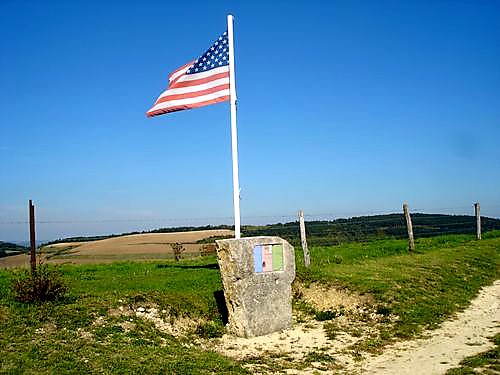Henry Gunther Memorial (Last KIA WW1)
Details:
On the east side by the trail.
Monument
Monument Text:
(Etched into the stone below)
En hommage
à
Henry Gunther
English translation:
In tribute
to
Henry Gunther
For the information panel:
(2nd column, English)
The last
American
killed
On April 6,
1917, the United States
of America
declared war on
Germany and
entered the First
World War on
the side of France
and her
allies. In a , two million
young
Americans. both volunteers
and
conscripts, were sent to
France.
General Pershing, the
Commander in
Chief of the
American
Expeditionary Force,
refused to
allow his troops to be
amalgamated
with French units
and
requested a separate
American
attack sector.
The US
troops were given the task of reducing the St. Mihiel Salient, an area in the
Department of the Meuse. The
assault took
place on 12 September 1918. Within three days the Americans, supported by
French units, had liberated
the salient,
which had been in German hands since September 1914.
Marshal Foch
then ordered another major offensive. This would begin in the Meuse-Argonne
region on 26 September
1918 and
thrust towards Mezieres. Foch wished it to be as violent as possible. The
offernive was to be carried out
by the first
American Army, supported by the Second French Colonial Corps, the 17th French
Army Corps and the
Fifth
Cavalry Division.
American
operations began on 26 September 1918 and came to an end on 11 November 1918 at
11am. There were
three
phases:
• from 26
September to 3 October : the initial assault.
• from 4
October to 31 October : the main battle.
• from 31
October to 11 November : advance to victory.
On the
American right wing, the final assault was carried out by the 26th and 79th Infantry
Divisions. The Germans
were pushed
back to a line running from Damvillers to Romagne-sous-les-Cotes but were
ordered to hold at all costs
the position
known as the Kriemhilde line. On 10 November 1918, the village of
Chaumont-devant-Damvillers and
the
surrounding hills were liberated by the 313th, 314th and 315th US Infantry
Regiments. Ahead of them, the German
31st
Landwehr Infantry Regiment put up furious resistance.
Henry,
Gunther, a native of Baltimore, was in Company A, 313th Infantry.
Aged 23 and
of German origin, Gunther had previously worked in a bank and was
to be
married when he returned home. Following the censor's interception of a
letter
critical of army life, Gunther, who had previously been promoted to Supply
Sergeant,
was downgraded to Private. He was wounded at the start of the
Meuse-Argonne
offensive but refused to be evacuated, preferring to remain with
his
comrades.
Although it
was known early on 11 November that the Armistice would take effect
at 11am that
day, the High Command ordered the assault to continue to the last
minute.
Emerging from a bank of fog, Private Gunther and his friend, Sergeant
Powell,
found themselves confronted by two German machine gun squads
manning a
road block. The Germans watched in disbelief as the Americans came
forward.
Powell and Gunther threw themselves to the ground, as bullets cracked
overhead.
The Armistice was imminent and the Germans ceased firing, believing
that the
Americans would have the good sense to stop. Their sacrifice would not
change the
war. Suddenly, Gunther got up and ran at the enemy. Sergeant Powell
ordered him
to stop. The German gunners signalled to him to go back but
Gunther kept
advancing. One of them fired a five-round burst. Gunther was struck in the left
temple and died
instantly.
It was 10.59am. One minute later, the Armistice took effect and silence
descended on the front.
Later, there
were scenes of fraternization and in the evening the Germans fired off all
their rockets, lighting up the
sky over
their positions.
General
Pershing's Order of the Day recorded Henry Nicholas Gunther as the last
American soldier to die in the First
World War.
He was posthumously promoted to Sergeant and received the Distinguished Service
Cross. In 1923,
Gunther's
body was returned to Baltimore and buried in Section W of the Holy Redeemer
Cemetery.
This
memorial renders homage to Gunther and his comrades, whose actions here pushed
the Americans advance in
the Verdun
sector to its furthest extent.
Translation : Christina
Holstein
Commemorates:
People:
Units:
313th Infantry Regiment, 79th Infantry Division
79th Infantry Division
American Expeditionary Forces (AEF)
United States Army
Wars:
WWI
Battles:
Meuse-Argonne Offensive

